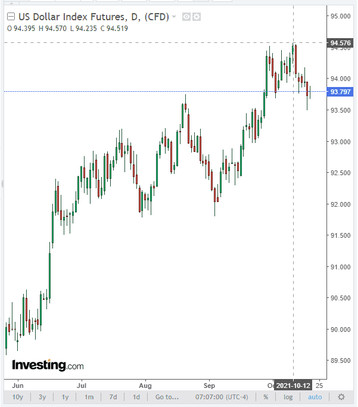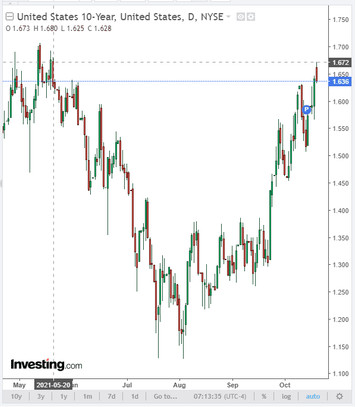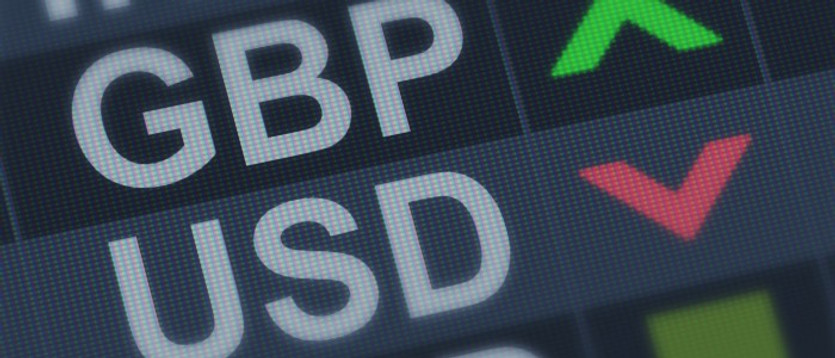The pound is declining in the first half of today's European session. Its decline accelerated after the publication of inflation indicators at 06:00 (GMT), which indicated a slowdown in inflation in the UK in September.
The consumer price index (CPI), which reflects the dynamics of retail prices for a group of goods and services that make up the British consumer basket, and is a key indicator of inflation, came out with a value for September of +0.3% (against the forecast of +0.4% and +0.7% in August). In annual terms, the growth of the British CPI amounted to +3.1% (against the forecast of +3.2% and +3.2% in August).
The UK Producer Selling Price Index (PSPI) also came in at September values, mostly weaker than the forecast and previous values.
Following the release of the indices, the GBP / USD pair is down about 0.4% by the time this article was published, to 1.3755. On Tuesday, the GBP / USD pair briefly rose to a new 5-week high of 1.3832, mainly amid a weakening dollar (in particular, dollar buyers reacted negatively to weak macro statistics from the US and a sharp decline in industrial production in the US in September, by -1.3%, while the market expected to grow by +0.2%).
The slowdown in inflation, on the one hand, is a negative factor for the pound, as it postpones the likelihood of the Bank of England raising the interest rate to a later date.
On the other hand, the decline in inflation strengthens the national currency.
At the same time, economists expect a sharp acceleration in inflation in October due to higher utility tariffs and a partial increase in VAT. In addition, prices for energy and gasoline are growing, and their deficit remains. According to economists, the slowdown in inflation in September is unlikely to force the Bank of England to stop raising its key interest rate from the current level of 0.1% in the coming months, as previously announced by the central bank leadership. For example, the head of the Bank of England, Andrew Bailey, recently said that due to high inflation rates, the central bank will probably have to act a little faster than originally anticipated. In late September, Andrew Bailey hinted that despite weak economic growth, the Bank of England may soon raise interest rates to moderate inflation.
The Bank of England expects that in April 2022 the annual inflation rate will accelerate to about 5%, and by the end of 2022 it will slow down to the target level of 2% set by the bank. Nevertheless, the bank's executives fear that high inflation rates will persist for a long time, therefore, they may nevertheless begin to tighten monetary policy, despite the possible negative scenario of a slowdown in the British economy due to the growing shortage of goods and labor resources. The combination of these two factors - weak GDP growth with the threat of stagflation and high inflation - is a dangerous situation for the economic development of the country, which recently completed Brexit.
Nevertheless, the attitude of the Bank of England management regarding the tightening of monetary policy remains tough so far. Now, many market participants assume that the Bank of England's key interest rate could reach 0.45% by the end of 2021 and 0.95% by June 2022. The pound quotes also include an increase of another 15-30 basis points based on the results of the next few meetings of the bank.
On the one hand, the tightening of monetary policy under normal conditions, as a rule, leads to the strengthening of the national currency.
However, in the current unusual conditions of the British and global economies, the reaction of market participants to the interest rate hike by the Bank of England may be mixed. Some economists consider such a move by the Bank of England to be a mistake, given the problems facing the British economy, including after Brexit, as well as the situation with rising energy prices, which continue to update record highs. Paying gas, electricity and oil bills is becoming increasingly difficult for British households and businesses, and raising the interest rate could prove to be a political mistake, which in turn will worsen the long-term outlook for the pound, economists say. In the UK, the population is making panic purchases of fuel, many gas stations are closed due to the lack of gasoline, and with the beginning of the heating season, the situation may worsen, which creates preconditions for the exacerbation of the economic crisis in the country.
An interesting picture is also emerging from a technical point of view. As we noted above, the GBP / USD pair is currently traded near 1.3755, through which an important long-term support level passes (see Technical Analysis and Trading Recommendations). A confirmed breakdown of this level can determine the direction of the GBP / USD pair dynamics towards the support level 1.3705, the breakdown of which will exacerbate the negative dynamics of the pair. However, for the development of such scenario, support from the dollar is still required, provided that it resumes strengthening. As of this writing, DXY futures are traded near 93.79, 78 points below the local 13-month high of 94.57 reached last week and 30 points above the local 3-week low reached yesterday near 93.49.
Market participants assess the prospects for the Fed's monetary policy, which is extra-soft and will remain so even after the November meeting of the US central bank, at which its leaders are expected to reduce the volume of purchases in the bond market, which is currently $ 120 billion a month.

Market participants await the publication today (at 18:00 GMT) of the Fed's report on economic conditions, known as the Beige Book.
Meanwhile, the yield on US government bonds continues to grow, supporting the dollar. Today, the yield on US 10-year bonds is up 1.672% from 1.634% yesterday, hitting its highest since May.

As for the pound, the official report is due this week with fresh data on retail sales in the UK in September. The Office for National Statistics will publish it on Friday (06:00 GMT). Consumer spending accounts for a significant share of UK GDP, and the expected annual decline in this indicator is another negative factor for the pound, indicating a decline in consumer confidence and their faith in the country's economy. In August, the level of retail sales (excluding fuel), as determined by the Office for National Statistics, fell -0.9% (y / y) in the UK after falling -2.5% in July. Another drop in the value of this indicator is expected by another -1.7% in September.
This is a negative factor for the pound. While the Bank of England is approaching a rate hike phase, the negative effects of the pandemic, supply problems, Brexit and rising energy prices fueling inflation could be key factors and severely slow the recovery of the UK economy.





